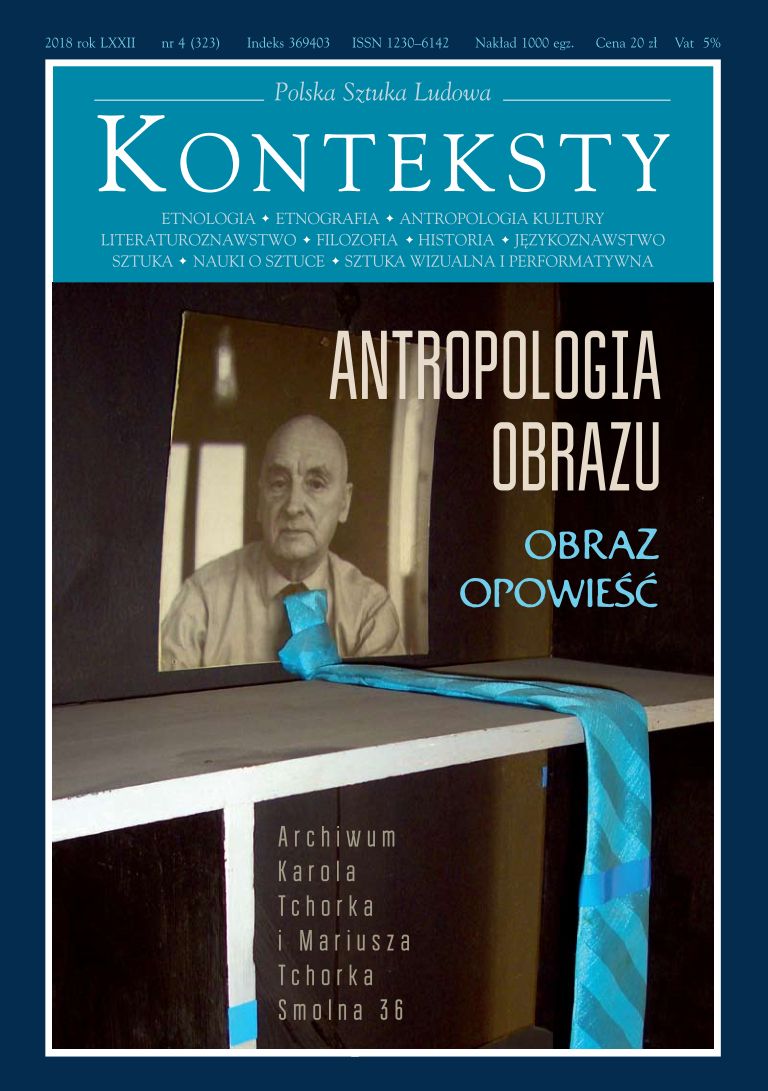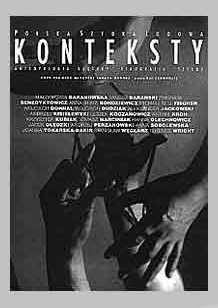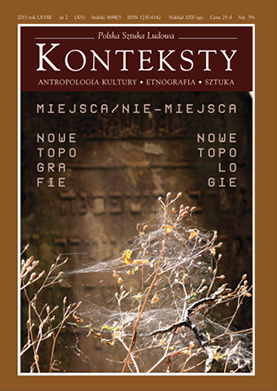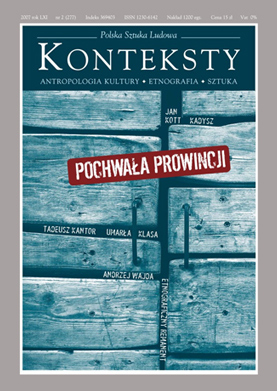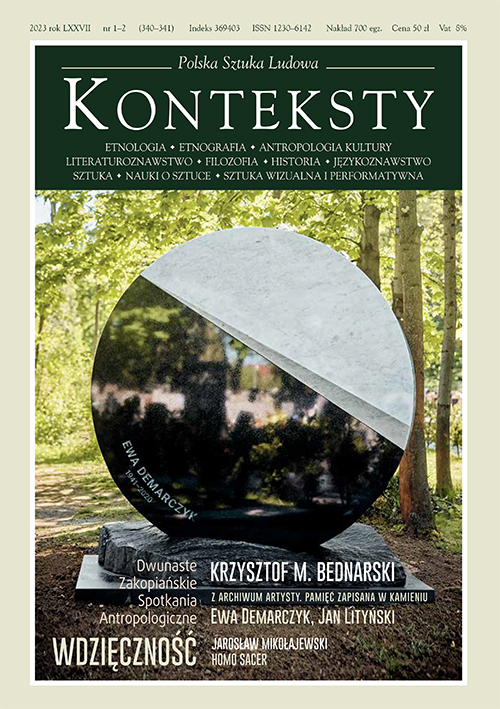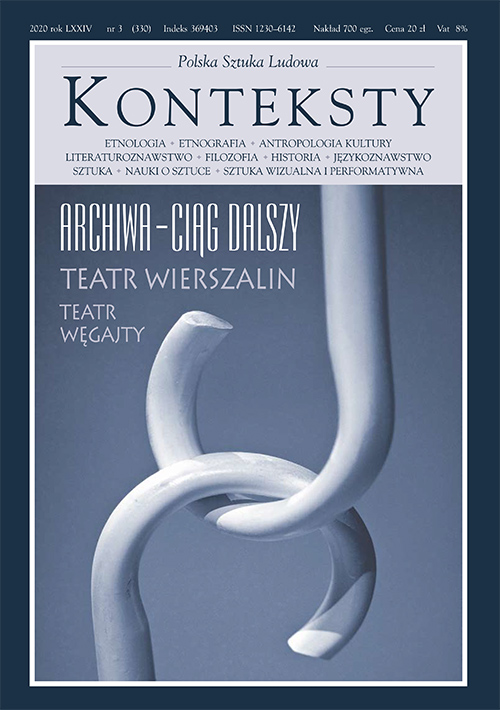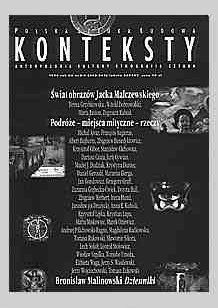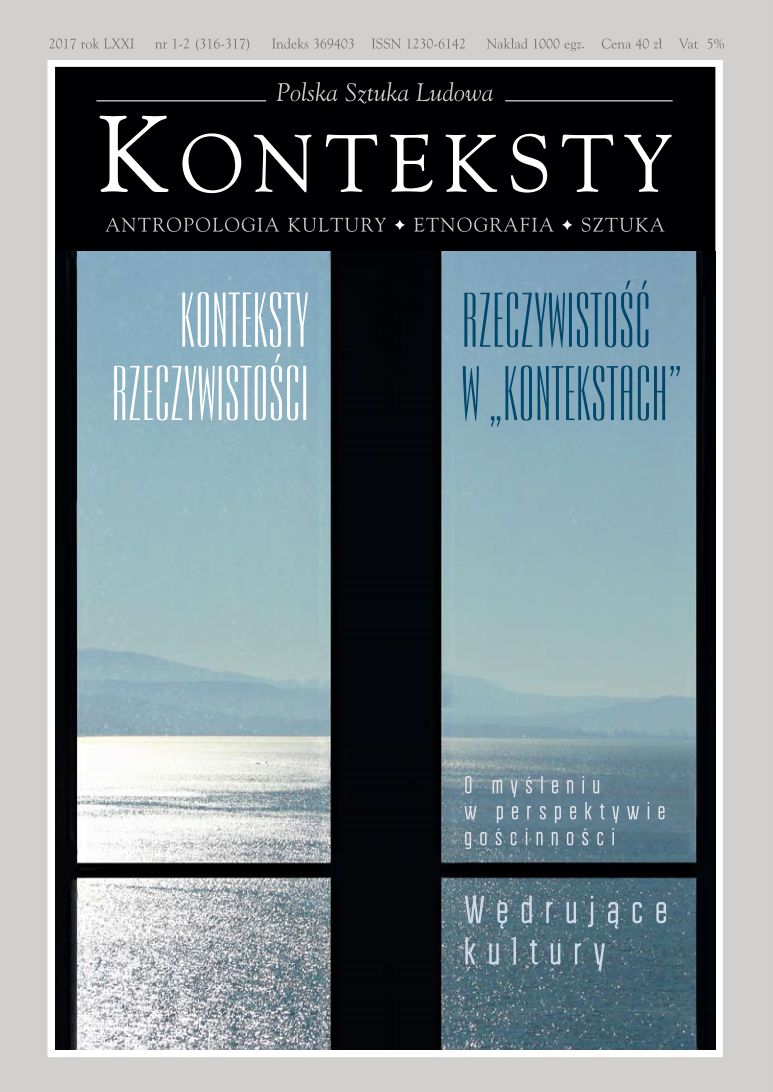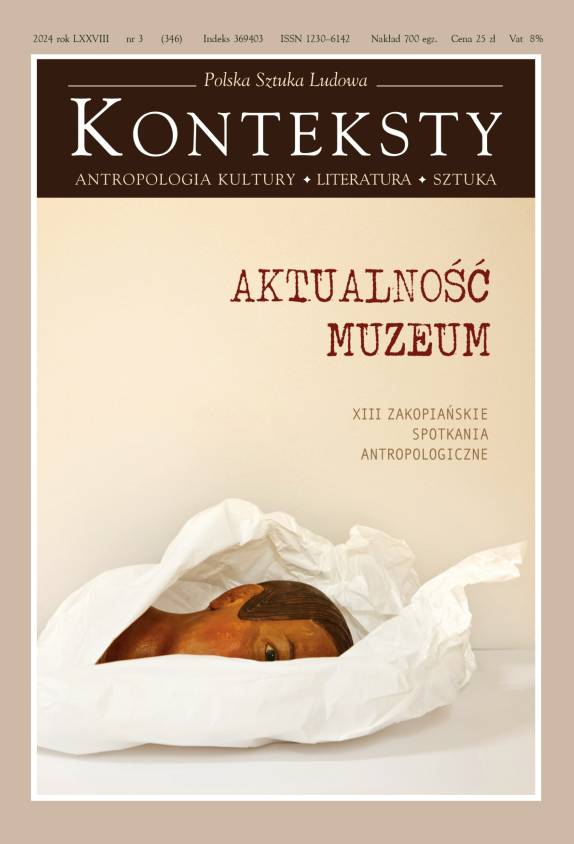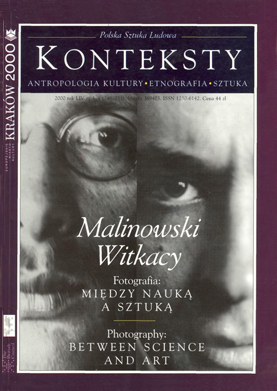Issue 2009/3 (286) - Konteksty

| Wiesław Juszczak | Before History: the Chief Forms of Time  | 3 |
Only through time time is conquered – Eliot wrote. Discussing the conceptions expounded by St. Augustine, Aristotle, Mircea Eliade, Francis Cornford, Lucien Levy-Bruhl, Maryla Falk, and John S. Mbiti relating to ancient Greece and India, Christianity and African religions, the author attempted to capture the essence of the paradox of time, and to describe the moment of the transition from myth to history. | ||
| Wacław Oszajca | The God of Contemporary Poets  | 11 |
Theodor Adorno asked whether lyrical poetry is at all possible after Auschwitz. The consequences of the Second World War disturb both the philosopher and the priest. In what way can we justify our existence? The author seeks a solution among poets writing about the encounter of man and God: T. Rożewicz, D. H. Lawrence, Z. Herbert, E. Lasker-Schuler, J. Seifert, and Cz. Miłosz. | ||
| *** | ||
| Carlo Ginzburg | Latitude, Slaves and the Bible: An Experiment in Microhistory  | 19 |
Carlo Ginzburg’s Lecture (20.01.2004) presented in The Roland Barthes Center, published in French: Carlo Ginzburg, Marie-Jose Mondzain, Michel Deguy and others, Vivre le sens – Centre Roland Barthes, Seuil, Paris 2008. Published in English in: „Critical Inquiry”, Volume 31, no 3, Spring 2005 p. 665-683 Latitude, Slaves, and the Bible: An Experiment in Microhistory. | ||
| Françoise Gaillard, Carlo Ginzburg, Julia Kristeva | 25 | |
| Elżbieta Wolicka-Wolszleger | The Power of Interpretation  | 29 |
In her remarks on Karol Berger’s The Power of Taste, which had just appeared in a Polish translation, the author defined the book as an attempt at a conciliation of traditional theoretical reflections on art, respecting the principle of the autonomy of the artistic and aesthetic spheres, and the 'new paradigm' of the interpretation, introducing the 'world of art' into the universe of culture. | ||
| Wojciech Bałus | Exit from the Shadow  | 32 |
As a rule, it is difficult to capture the traces of a decision made by a young artist about his entry into the 'adult' world of art. Veranda by Wyspiański – his early, 'borderline' work – encourages the reader to delve deeper. The interior of Wyspiański’s veranda is secure and tamed but leaving it carries some sort of a threat. Crossing the threshold denotes a step into the unknown. Perhaps this will be the beginning of a march into the realm of light and warmth or of something quite the opposite – a fall into a precipice... | ||
| *** | ||
| Bohdan Michalski, Beata Di Biasio | The Symbols and Myths of Europe from the Viewpoint of the East and the West | 36 |
| Bohdan Michalski | Europe Divided or „Balanced”  | 38 |
The author deals with assorted aspects of the integration of contemporary Europe, in which up to now the economy played a priority role. Today, however, the united European project gives pride of place to other fundamental questions: whether the Europeans will become a single nation, or whether the divided memory of Europe will stand in their way? Will it become possible to overcome the different historical experiences of the West and East and discover a joint foundation that will facilitate mutual rapprochement? Finally, will the „European dream” about a single nation living in harmony and sharing symbols, dreams and targets, come true? All the conflicts and apocalyptic genocides of the twentieth century will remain a warning and a recollection. | ||
| Beata Di Biasio | Europa and Zeus, Woman and Bull. The Ahistorical and Laic Version of the Myth of Europe in Paintings by Hoffman and Lebenstein  | 45 |
„The Polish government commissioned from Franciszek Starowieyski, the renowned Polish painter, a composition to embellish the new building of the Permanent Representation of the Republic of Poland at the European Union in Brussels. The monumental Divina Polonia rapta per Europa profana, executed in 1998, was put on permanent show in the main hall of the Permanent Representation seat. ‘Divina Polonia’, the second female figure featured in the canvas next to Europe, is depicted with a halo. F. Starowieyski referred to the classical myth of Europe (a Phoenician princess abducted by Zeus disguised as a bull) in order to emphasize the contrast between secular Europe and ‘holy’ Poland. What is the source of this combination of nudity and saintliness? Why has this otherwise liberated artist, who in hundreds of compositions obsessively portrays the female nude and remains distant from bigotry or clericalism, suddenly resorted to religious symbols. These intriguing and disturbing questions arose after seeing an exhibition on the myth of Europe shown in Florence. There, works of twentieth-century artists from Western Europe did not contain religious symbols. We seem to be approaching the topical problem of the unity of Europe. The canvas Divina Polonia rapta per Europa profana is a symbolic summary of the two different historical experiences of the East and West of Europe. In Eastern Europe it was precisely culture and religion which proved to be the strongest fortress in the battle waged by the smaller nations of this part of the Continent against the imperialism of their more powerful neighbors. This issue, reflected in myth and expressed in Polish twentieth-century painting, remains an unresolved topic of fascinating interdisciplinary studies (history of art and political anthropology), whose results I shall attempt to present in my dissertation… Polish twentieth-century painting expresses two embodiments of the myth of Europe. On the one hand, the 'western' version, similarly to western art in general, recounts the story of twentieth-century European civilization, describes women’s liberation, and comments on the interminable relations between man and woman (Skoczylas, Nacht-Samborski, Manastyrski, Linke, Hoffmann, Lebenstein, Nowosielski). The same myth is also present in a ‘Polonised’ version (Starowieyski, Hasior, Grzywacz, Dwurnik), and undergoes a transformation into the ‘antemurale’ myth, which has shaped Polish historical identity for centuries…” | ||
| Anna Czajka | On the Search for Identity in Aesthetic Communication between Cultures  | 54 |
The article is concerned with the problems of European identity, as defined in the process of aesthetical communication among cultures. Such an approach to the question of identity is based upon a conception of culture centred about the aesthetical experience (Vico, Schiller, Brzozowski); in this centre we see the forming of the autotelic kernel (Ossowski, Kłoskowska) of those symbolic systems (leading imagines, musical intensities, apriorical structures of aesthetical perception) which are constitutive for the single national cultures. The aesthetical forms contained in such kernels are especially predisposed for the relationships of communication, in which new fusions often occur and new forms develop themselves, which represent an increase of prior forms and denote a common horizon for until now distinct cultures. An activation of aesthetical communication, possibly based upon cultural polyvalence (Kłoskowska), would be the first step to perform in our global and intercultural situation, in order to facilitate the mutual understanding in the political, legal or economical domain. Aesthetical communication marked the stages of European history (Italian Renaissance, French and European Classicism) and is particularly intense today (even with the momentaneous character of aesthetics in our times), especially in the domain of art production (examples will be analysed), although it does not enough influence the sensus communis because of the marginalisation of this culture sphere, in which the horizons of culture are designated by art. | ||
| Magdalena Złocka-Dąbrowska | Georges Dumézil and the Concept of Europe  | 60 |
The ideas proposed by Georges Dumézil could prove useful in the current discussion about Europe, which asks whether European culture is an expression of the unity or the multiplicity of cultures. His theory about three social functions is based on material representing assorted Indo-European cultures, but becomes an expression of the unity and community of the cultural complex that is Europe. Dumézil’s classical work remains interesting even if should be transferred onto a shelf with the belles lettres. | ||
| Joanna Nowicki | The Myths and Symbols of Central European Cultures  | 65 |
In Central Europe culture played a fundamental part in creating social bonds and the shaping of identity. Myths and symbols present in literature, painting and music possess a strong political connotation. In contrast to the western part of the Continent, which with the assistance of literature created myths and symbols endowed with a universal quality, in Central Europe they are always firmly associated with national history. The difficulty of studying that which transpires in Central Europe stems from, i.e. the overlapping of the „western” and „eastern” models, from which assorted features are borrowed while adding one's own, original solutions. This state of affairs calls for exceptional alertness, since the evolution of Central Europe is the resultant of choices and the direct surrounding, often known as the „geopolitical situation”. The presented text is an attempt at analysing several myths and political symbols envisaged as the mechanisms of identity and difference. This concrete question – the attitude towards memory and oblivion – is shown as an example of the profound difference between the cultural psychology of Central Europe and the West, Europa felix. | ||
| Wawrzyniec Konarski | Ethnoregionalistic Movements in Europe: Reshaped or Disfunctional Image of European Future?  | 72 |
Recent decades clearly confirm that ethnicity and regionalism become key words for the processes which are developing simultaneously with the European integration. Thus they remain in mutual dependence and demonstrate their impact on the nation-state in its most transparent, i.e. post (French) revolutionary understanding. The European integration in particular generates a tendency towards ethno-political differentiation of regions, which in this way may be encouraged to escalate their educational, economic, legal, and purely political demands. As a consequence it has an impact on the weakening of a nation-state. The term regionalism – relying upon the local specific – may be perceived in several ways. However, the intention of the hereby article is to understand it as an (ethno) regionalistic movement. Such approach justifies to perceive it as a synonymous with a nationalism of small and dependent nations, as well as ethnic and national minorities. These entities are forced to strengthen their existence while remaining under pressure from large (state) nations which dominate in already existing nation-states. In other words the (ethno) regionalistic movements appear as a small ethno-national entities’ reply on the above quoted large (state) nations’ pressure. It should be here added that the (ethno) regionalistic activities in most cases are typical for many West European states (Faroe Islands and Greenland in Denmark, Bretagne and Corsica in France, South Tyrol in Italy, Basque country, Galicia and Catalonia in Spain, Scotland and Wales in Britain). However, their presence is also noticeable in selected East-Central European (ECE) countries. Bearing in mind its geographical and historical limits it is confirmed by Poland (German minority and Silesians in particular), Austria, Romania, Serbia and Slovakia (Hungarian national minority in those four cases) or on a limited scale by the Czech Republic (Polish national minority). The nature of the ECE quoted examples is irredentist in its character, whereas the Western examples are manifested mostly by their demands towards the regional autonomy, its deepening or in some cases even to an independent status. | ||
| Dariusz Czaja | Europe and Its Shadow. History and Metaphor  | 80 |
An attempt at an anthropological view of the history of twentieth-century Europe from the point of view of metaphorology. The author tried to reconstruct its cultural and ideological idiom via the prism of two metaphorical figures: the 'home' and the 'spirit'. Consequently, he conducted a more detailed analysis of the contents of such expressions as: 'the European Home' (an instructive example being the book by the French politologist T. Delpech: Savage Century: Back to Barbarism) and the 'Spirit of Europe' (an important vision from a collection of lectures by the Czech philosopher and theologian Tomaš Halik: Summoned or Not, God Shall Appear). The knowledge about the essence of the 'European quality' (especially in its twentieth-century form) that emerges from an analysis of the two expressions does not incline towards optimism. The texts by both authors disclose that apparently 'the European Home' denotes not only a safe region, but also the dark 'basements' inhabited by phantoms. In turn, the 'Spirit of Europe' is an expression that, alongside bright connotations, also contains sinister (wild and untamed) regions of the subconscious. Only the inclusion of those undesired and forgotten spaces into living European awareness (a sui generis counterpart of Jung’s 'integration of the shadow') can become a condition for its spiritual renascence. | ||
| Jerzy Miziołek | „Flammans pro recto”. Several Reflections about the Last Members of the Lanckoroński Family, or on Patriotism, European Artistic Culture and Classical Tradition  | 90 |
In October 1994 and June 2000 a significant number of Italian paintings from the collection of Count Karol Lanckoroński (1848-1933) in Vienna were donated to the Royal Castles in Krakow and Warsaw. This generous gift was made by Count’s daughter Karolina Lanckorońska (1898-2002), then the only surviving member of the family. The Warsaw Castle received Baroque and Neoclassical paintings whereas Renaissance paintings – including works by such artists as Simone Martini, Bernardo Daddi, Apollonio di Giovanni, Jacopo del Sellaio, Garofalo and Dosso Dossi went to Krakow. They depict, among others, Orpheus, Odysseus, Paris and Helen of Troy, Narcissus, Marcus Curcius, Horatius Cocles, the vestal Tuccia, Scipio Africanus, Vergil and Julius Caesar. Thus the rooms of the Krakow residence of the Polish kings, built in the first half of the 16th century by two Italian architects, Francesco Fiorentino (d. 1516) and Bartolomeo Berecci (d. 1536), were enhanced by the paintings of their compatriots. The Lanckoroński donation complements beautifully the all’antica and all’italiana ‘aura’ that exists in the Castle. It was on the Castle (or not far from it) that Filippo Buonaccorsi, known as Callimachus wrote a letter to his friend Marsilio Ficino calling him „the new Orpheus”, it was here that in 1515 and in 1522 a play was performed about Odysseus/Ulysses and Paris, and even earlier the song of the Sirens had been written about. In 1518 it was also here the King Sigismundus I married Bona Sforza. To mark the occasion of that famous wedding, Andrzej Krzycki wrote a charming verse, in which he describes Bona as „radiating” the best characteristics of all the three goddesses known from the Judgment of Paris – Venus, Pallas Athena and Juno. The splendid and memorable gift of the last of the Lanckorońskis to the Royal Castle was indeed the crowning point of the many activities undertaken by Karol Lanckoroński such as the restoration and conservation of the buildings on the Wawel Castle Hill. In 1994, Karolina so wrote about her father: „Together with a group of friends [...] he fought [...] at the beginning of this [the 20th] century a Homeric-like work to release the former residence of the Jagiellons from its use as Austrian barracks.” At the beginning of the 21st century, nearly 100 years after the Castle was rid of foreign armies (in 1905), the former residence of the Polish monarchs which had been ruined by the partitioning powers, once again emanates an atmosphere of the Italian Renaissance, as in the 16th century, the Golden Age of Polish culture, and all thanks to the collection amassed in Vienna and the generosity of Karolina Lanckorońska. | ||
| Radosław Stanczewski | Europe as a Crystal Palace  | 110 |
Fifteen years after the fall of the Berlin Wall, the range of the European Union has expanded after the access of the post-communist countries of Eastern Europe, thus making it necessary to tackle the cultural differences and divergent visions of the Community’s development. Undisturbed functioning under the roof of the crystal palace of the Europe of the twenty first century has been undermined, and the palace walls are starting to disclose cracks. Will the myth of the Continent, united against all odds, survive such a confrontation of two different worlds? | ||
| Marek Haftek | The Brain Drain or the Principle of Communicating Vessels. An Incessant Striving towards an Optimal Solution  | 112 |
The author recalled the story of Maria Skłodowska-Curie, comparing it with present-day intellectual emigration, scientific exchange and the problem of the brain drain. | ||
| Filip Bajon | Filippo Brunelleschi and the Battle of Grunwald  | 114 |
The early fifteenth century – Filippo Brunelleschi and a Polish knight fighting at the battle of Grunwald. Two people living in the same period but belonging to different worlds – the world of the waning Middle Ages, together with its chivalric ethos, and the world of classical antiquity transposed for the sake of glorifying man. Can those two worlds meet in some sort of harmony? This is the eventuality described in the scenario of the film Cień kopuły (The Shadow of the Dome), whose premises are presented by its author. | ||
| Dariusz Czaja | The Height of Perversion. Venice of Two Worlds  | 116 |
The presented text is an attempt at an anthropological approach to the image of Venice presented in Perversion by the outstanding Ukrainian author Yuri Andrukhovych. In this sophisticated literary joke, the author conducted an ironic and refined deconstruction of the stereotypical likeness of Venice, recorded in numerous literary texts. He reverts the signs and shows the second, darker side of the over-aestheticised and melodramatic portrayal of the town. As always, Venice proved to be a magnifying glass of European civilisation, but in the case of Andrukhovych it is a crooked mirror of the contemporary 'post-carnival nonsense of the world', as in the title of one of the papers read at a seminar of pseudo-intellectuals described in the novel. | ||
| Kasper Bajon | The Rhine – Notes  | 121 |
The narrator of this brief sketch spent several hours in Basel before the European Championship quarter final between Portugal and Germany. Sitting on a stone riverbank and dipping his toes in the Rhine, he ponders on Europe, its intellectual-political image and contemporary condition. In this manner, Basel, located along the borderline between three states, becomes the heart of the Continent, and the Rhine, which, the author claims, is a frontier dividing Europe into the West and the Central East (Roman and barbarian), is its main blood vessel. In the presented text, Basel, which survived both world wars untouched, appears to be a sui generis place beyond time (or actually above time) and space. Here, the experience of the gas chambers is not constitutive – something that an inhabitant of Central-Eastern Europe finds, on the one hand, inconceivable and, on the other hand, greatly perspectivistic since it does not create any restraints. This is the reason why the situation of the narrator in Basel differs from the one in places defiled by war; in other words, he is at liberty to do slightly more. This is also the reason why the sketch has the form of loose notes (as if made on the margin of an exercise book), whose outcome and order are determined only by the origin of the author’s associations with the Rhine and Basel. Hence also such a wide spectrum of the described figures (the inventor of iperite Fritz Haber, Rembrandt, Nietzsche, Hitler, De Muralt, Frederic Holderlin) and places (Bolimow, Mauthausen, Dahlem, Ypres) – all to answer, if only partly, the question: what is Europe and what does its phenomenon consist of? | ||
| *** | ||
| Joanna Pietrzak-Thébault | Men’s Fashion in the Sixteenth Century – an Image of Virtue, an Understanding of the World  | 128 |
'Eyes in the face of a man with studied proportions, a perfectly groomed beard, a prominent nose and a disclosed right ear. The juxtaposition of colours enables it to clearly contrast with the snow-white edge of a crimped collar (being extremely high it reaches the neck). We can see only this rim (a ruche, discreet in comparison with the opulence to come in the future), similarly to the gathered cuffs, while the rest of the shirt remains concealed. A black beret decorated with a flowing tinted feather prolongs the effect of colour achieved by the raven-black coiffure. Even if the hair does show first noticeable lighter tinges, it is still devoid of greyness'. With this description of a portrait entitled Cavalier in Black by Giovanni Battista Moroni, Amedeo Quondam, one of the leading contemporary Italian experts on sixteenth-century literature, began his book on the men’s 'black' fashion at the Italian and European courts of the sixteenth century – Tutti i colori del nero. Moda e cultura del gentiluomo nel Rinascimento (series Rinascimenti, Angelo Colla Editore, Costabissara /Vicenza/ 2007). Cavaliers, poets, princes and emperors dressed in black irrevocably replaced the colourfully attired courtiers of the previous generation – a turn of centuries and of epochs. Fashion cased being solely an expression of social status and became also a question of individual choice. In this ostensibly trivial phenomenon the author sought symptoms of profound cultural changes upon the threshold of Classicism. Quondam showed how much there is to define and comprehend of what he described as the 'new classical culture', as well as the need for a skill necessary to benefit from assorted thematic fields – starting with the history of art, material history, the history of editorship and the anthology of colour to literature and semantics. For the purpose of understanding these transformations he made use both of the avant-garde literature of the period, with the invaluable Il Libro del Cortegiano by Baldassare Castiglione, and extremely popular genres, today regarded as secondary: dialogues on the nature of love, treatises about the symbolic of colour, emblematic-heroic impresse, descriptions of court ceremonies, etc. In doing so, he penetrated changes of manner and morals, dealt with the technology of dying fabric and the production of paint, browsed through posthumous inventories, recalled the reconstructions of authentic costumes, resorted to semantic analyses and evoked the history of native and borrowed words. Upon numerous occasions he managed to topple statements repeated for years without any suitable verification, such as those about the origin of the 'black' fashion accepted on the Apennine Peninsula together with Spanish domination. The author linked facts that at first glance appear to be distant: the dates of the editions of particular writings, royal visits, imperial funerals… In assorted 'micro-signs' he discerned the power of explaining global phenomena and taught this quickness of perception to the reader. The story is illustrated with a series of court and burgher portraits by Titian, Raphael and Moroni, as well as other more or less known or outright anonymous artists of the period, thus showing the universal nature of the described phenomenon. The process of taming the colour black, a hue of grief and madness, the intentional rejection of ostentation and brilliance, the praise of moderation, the emphasis on the noble fabric and monochromatic contrasts of colours were to comprise not only one of the most essential features of Classicism, but also a foundation for the creation of a framework of national consciousness. The significance which fashion was to hold in the history of Italian culture, and the exceptional role which it was to play in shaping Classicism and in the retention of an awareness of the 'Italian form' in those centuries which historiographers are in the habit of calling dark, made it possible at the time of long-lasting crises to discover an inexhaustible source of inspiration. Today, it yields the supremacy of Italian style in fashion and industrial design, an original and inimitable elegance made in Italy, unvarying for decades. | ||
| Ilona Wiśniewska-Weiss | The Collector of Accidental Paintings  | 136 |
An analysis of the functioning of photography in literature upon the basis of W.G. Sebald’s novel Austerlitz, whose leading protagonist discovers, in the course of successive meetings with the narrator, the story of his life, marked by accompanying photographs of everyday objects, empty places, ruins of buildings, etc. Discussing critical texts on Sebald and an anthropological analysis of the photographic image by Hans Belting, the author proposed an expanded reflection, namely, that in this prose photographs witnessed the revelation of the trauma of the protagonist spinning the story, and became more of a source of fear, which he did not become aware of and which was caused by wartime experiences, than merely a transparent testimony of history. This does not pertain to the topics of the photographs, but to the photographic medium as such, whose characteristic property is to obliterate reality, to create a parallel world and thus to produce a trauma of the viewer, doomed to live in the imaginary world of reminiscences, offered in the photographs. Such a situation results directly in a sui generis compulsive repetition – as when the protagonist, whose memory is blocked by the photographic images, returns over and over again to the same photographs in a vain attempt to compose his own past out of pictures which, ex definitione, cannot create historical evidence. | ||
| Marc Augé | Un Ethnologue dans le Métro. Reminiscences | 140 |
| *** | ||
| Krzysztof Rutkowski | Nymph  | 152 |
The Nymph is associated with the choreography of desire and death which Aby Warburg described as the stylisation of energy or figures of the lushness of life. The Nymph renders struggle erotic, and reveals unconscious bonds between aggression and desire. For this reason Warburg was interested in the motif of violence, abduction, the erotic chase or the 'erotic victory' of the Nymph over her wounded opponent (Judith by Botticelli, Death of Orpheus by Mantegna or Durer). The Nymph is an erotic force, and the battle is fierce due to the cruelty of Eros. Not only does the Nymph concentrate the strife in her body but she also becomes an amorous confrontation, a knot of desires. In doing so, she turns into a Maenadis succumbing to Dionysian frenzy. | ||
| Leszek Kolankiewicz | The Experienced Theatre according to Michel Leiris  | 160 |
A record of a lecture given in the Institute of Art at the Polish Academy of Sciences during a session on Michel Leiris. The author recalled Leiris’ texts on African cults of possession, and reconstructed his comprehension of the theatrical spectacle, the ritual, and 'theatricality'. He also granted new contexts to the categories used by Leiris – 'the enacted theatre' and 'the experienced theatre'. | ||
| Jan Gondowicz | The Maudits  | 166 |
The author brings the reader closer to the history of College de Sociologie, established by Georges Bataille, Roger Caillois, Michel Leiris and Jules Monnerot, and active in Paris in 1937-1939. This ambitious attempt at combining sociology, politics and life under a single guise, is assessed from the perspective of time as an epilogue of the pursuits of interwar artistic avant-gardes – as the most radical attempt at merging the social sciences and art. For others, the College was, despite incessant attempts at transcending beyond the literary domain, the 'last group of the literary avant-garde'. The author suggested that a similar, albeit failed endeavour to 'cast light on the mysteries of the practical life' was the intention of Karol Irzykowski’s periodical 'Meteor' (1898)... | ||
| Tomasz Szerszeń | Anthropology as a Mask, a Costume, a Metaphor: the Case of Michel Leiris and Roger Caillois  | 170 |
Michel Leiris and Roger Caillois are the authors of two rather strange autobiographical works: L’Âge d’Homme, and a self-analytical essay La Nécessité d’esprit, not published during the author’s lifetime. Leiris began writing L’Âge d’Homme before he was thirty years old, and Caillois completed La Nécessité d’esprit – his first book – when he was less than twenty years of age. In other words, we are dealing with two works that treat the problem of the autobiography in a truly surrealistic manner: they are the stories of a life that has not been lived but has barely began. L’Âge d’Homme and La Nécessité d’esprit also relate, in a less unobvious way, to a different theme: the attitude of the authors to 'scientificality'. After all, Leiris and Caillois were men of science (an ethnographer and a sociologist). Reading their learned analyses, one could have the impression that anthropology is a metaphor, a mask or a theatrical costume. In the case of Leiris, the onset of interest in ethnography coincided with the inauguration of work on L’Âge d’Homme. This was also the moment when the author became involved in editing the avant-garde periodical „Documents”, in which anthropology and ethnography were for the first time applied as a sui generis quasi-science, a scientific discourse transferred, laid open, at times mocked and simultaneously proposed misleadingly as a scientific debate. It was precisely for the needs of „Documents” that Leiris assumed the role of an ethnographer, and adapted himself – in the manner of one of the insects described by Caillois – to 'writing science'. For Caillois too science – sociology, anthropology – is a mask concealing the temptation to write an autobiography, a metaphor of one’s existential situation. Here, the key figure is that of the praying mantis, a combination of sexuality and autobiographical qualities. Similarly to Judith, the praying mantis is connected with an autobiographical project of describing emptiness, a life not lived, whose place has been taken by science. The texts by Leiris and Caillois render us helpless. We are not certain whether that which has been presented as a scientific discourse is actually one. Or is it a metaphor, a mask, a game played by textual mirrors, in whose course the authors themselves have provided the best possible keys to an interpretation of their texts that, in turn, function as perverse auto-commentaries. This is a science that, in the fashion of the headless Acéphale, is always missing something, in which something is not in its proper place, but is shifted and multiplied. This is a science that resembles a cruel praying mantis, and has been created to make the naive researcher feel at loss. | ||
| Karolina Lewandowska | Between Subversion and Aesthetics – Surrealism and Photography  | 173 |
The functions fulfilled by Surrealistic photographs published in periodicals remain suspended between two extremities, orders and different practices, between subversion and aesthetics. The first is connected with the actual activity of the artists, and the second – primarily with the activity of the interpreters. On the one hand, photographs undermine their credibility and status of fully-fledged works of art, and are revolutionary in relation to the text or represented reality; on the other hand, they possess forms sufficiently expressive and beautiful so that in time they start to act in favour of building the renown of photographic imagery according to the modernistic categories of the autonomous medium. If it were possible to collect photographs functioning within the range of pre-war French Surrealism, the outcome would be an area for a confrontation with reality. Photographs are treated not as autonomous images but as representations devoid of a distance towards reality, and, quite possibly, even as part of the same phenomenological experience. They resemble extracted fragments of reality, in the manner of dreams, found objects, and all symptoms of psychic automatism or that of the world. | ||
| Michel Leiris | Nuits sans nuit fragment  | 176 |
Four dreams from Michel Leiris’ Nuits sans nuit et quelques jours sans jour from 1961 (Nights as Day, Days as Night), a precise and poetic record of his dreams and states between the dream and the awakening. | ||
| *** | ||
| Wiktor Stoczkowski | A Portrait of Lévi-Strauss as a Demographer: an Essay in the Anthropology of Science  | 177 |
Claude Lévi-Strauss frequently expressed the opinion (also in a conversation with the author of this article) that the greatest cataclysm he had witnessed is the inconceivable growth of the human population. As a rule, researchers studying his works are embarrassed by this declaration. Nonetheless, the author shows how a correct comprehension of the demographic aspects of the vision of the world proposed by Lévi-Strauss is indispensable for a suitable interpretation of all of his works, written by a moralist trying to concisely discover the reason for the evil present in the contemporary world and to find means that could save mankind from that evil. | ||
| Magdalena Barbaruk | The Heirs of Cervantes  | 188 |
The author reviewed the conversations of two famous Argentinian writers: Ernesto Sabato and Jorge Luis Borges, published in Buenos Aires as Diálogos (2007). The book offers the Polish reader new information about the relations between the two men of letters. The author characterised the universally known differences between them and then captured the breakthrough moment in the dialogues conducted in 1974: the attitude towards Don Quixote. Borges admitted that for many years he erred in his assessments of Cervantes and the hero of the novel (this was one of the reasons for Sabato’s enmity). This important confession becomes a key to capturing the 'secret and genuine similarity' of the antagonistic writers, expressed in the metaphor: 'the heirs of Cervantes'. The review is thus also a polemic with the image of Borges and a victory of the 'concealed', 'second' Borges (Sabato). The author enclosed a translation of a fragment of Dialogos illustrating the central thesis of the article (the problem of Don Quixote) and a fragment of a conversation about the tango. Music was probably the only phenomenon towards which Borges remained indifferent, but about which he spoke surprisingly often. Here, in the company of Sabato, he kept silence and admitted to helplessness, betraying only a taste for music and a familiarity with the phrases of the 'Rio de la Plata songs'. | ||
| Jorge Luis Borges, Ernesto Sabato | 192 | |













